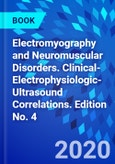Successfully correlate electrodiagnostic findings and neuromuscular ultrasound with key clinical findings with Electromyography and Neuromuscular Disorders, 4th Edition. This popular text is the go-to resource for clinicians at all levels of experience who have an interest in neuromuscular medicine, including those studying for the AANEM board exam. An easy-to-read writing style, abundant case studies, and learning features online help you master the electrodiagnostic evaluation and improve safety and accuracy.
- Helps you diagnose neuromuscular disorders more quickly and accurately, and correlate electromyographic and clinical findings.
- Explains complex subject matter in an easy-to-understand, user-friendly manner.
- Includes dozens of detailed, cross-sectional anatomy drawings to ensure correct EMG needle placement and avoid neurovascular injuries.
- Features new chapters on Neuromuscular Ultrasound, as well as incorporating neuromuscular ultrasound in the evaluation of clinical neuromuscular disorders along with electrodiagnostic studies in many of the clinical chapters.
- Provides up-to-date information on iatrogenic complications of electrodiagnostic studies and newly defined genetic neuromuscular conditions.
- Includes online access to more than 70 videos that allow you to see and hear the EMG waveforms discussed in the text, as well as a convenient "Test Your Knowledge" module.
- Enhanced eBook version included with purchase. Your enhanced eBook allows you to access all of the text, figures, and references from the book on a variety of devices.
Table of Contents
Section I: Overview of Nerve Conduction Studies and ElectromyographyChapter-1: Approach to Nerve Conduction Studies and Electromyography
Chapter-2: Anatomy and Neurophysiology
Section II: Fundamentals of Nerve Conduction StudiesChapter-3: Basic Nerve Conduction Studies
Chapter-4: Late Responses
Chapter-5: Blink Reflex
Chapter-6: Repetitive Nerve Stimulation
Section III: Sources of Error: Anomalies, Artifacts, Technical Factors and StatisticsChapter-7: Anomalous Innervations
Chapter-8: Artifacts and Technical Factors
Chapter-9: Basic Statistics for Electrodiagnostic Studies
Section IV: Detailed Nerve Conduction StudiesChapter-10: Routine Upper Extremity, Facial, and Phrenic Nerve Conduction Techniques
Chapter-11: Routine Lower Extremity Nerve Conduction Techniques
Section V: Fundamentals of ElectromyographyChapter-12: Basic Overview of Electromyography
Chapter-13: Anatomy for Needle Electromyography
Chapter-14: Basic Electromyography: Analysis of Spontaneous Activity
Chapter-15: Basic Electromyography: Analysis of Motor Unit Action Potentials
Section VI: Clinical-Electrophysiologic Correlations Part I: Common Mononeuropathies:Chapter-16: Clinical-Electrophysiologic Correlations: Overview and Common Patterns
Chapter-17: Median Neuropathy at the Wrist
Chapter-18: Proximal Median Neuropathy
Chapter-19: Ulnar Neuropathy at the Elbow
Chapter-20: Ulnar Neuropathy at the Wrist
Chapter-21: Radial Neuropathy
Chapter-22: Peroneal Neuropathy
Chapter-23: Femoral Neuropathy
Chapter-24: Tarsal Tunnel Syndrome
Chapter-25: Facial and Trigeminal Neuropathy
Part II: PolyneuropathyChapter-26: Polyneuropathy
Part III: Motor Neuron DiseaseChapter-27: Amyotrophic Lateral Sclerosis and Its Variants
Chapter-28: Atypical Motor Neuron Disorders
Part IV: Radiculopathy, Plexopathies, and Proximal NeuropathiesChapter-29: Radiculopathy
Chapter-30: Brachial Plexopathy
Chapter-31: Proximal Neuropathies of the Shoulder and Arm
Chapter-32: Lumbosacral Plexopathy
Chapter-33: Sciatic Neuropathy
Part V: Disorders of Neuromuscular Junction and MuscleChapter-34: Neuromuscular Junction Disorders
Chapter-35: Myopathy
Chapter-36: Myotonic Muscle Disorders and Periodic Paralysis Syndromes
Section VII: Electromyography in Special Clinical SettingsChapter-37: Approach to Electrodiagnostic Studies in the Intensive Care Unit
Chapter-38: Approach to Pediatric Electromyography
Section VIII: Electronics and InstrumentationChapter-39: Basics of Electricity and Electronics for Electrodiagnostic Studies
Chapter-40: Electrical Safety and Iatrogenic Complications of Electrodiagnostic Studies








